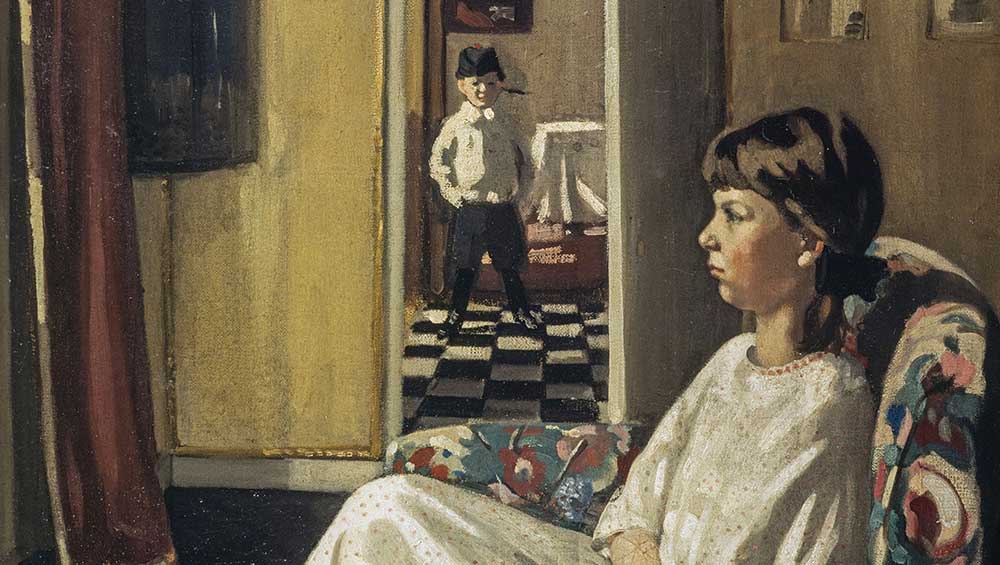
Mabel Pryde Nicholson, The Grange, c1911 (detail). Scottish National Gallery.
The Grange Gallery, Rottingdean, Sussex
20 July – 26 August 2024
by ANNA McNAY
The Nicholson family has long been well-known in the world of the cultured middle-class, with its key figures comprising the artists William and (his son) Ben; William’s daughter Nancy, a staunch feminist, illustrator and designer, who was married to the poet and novelist Robert Graves; another of William’s sons, Kit, a successful architect; and Ben’s first and second wives, Winifred Nicholson and Barbara Hepworth. But are you familiar with Mabel Pryde Nicholson, William’s wife, mother to Ben, Tony, Nancy and Kit, and herself descended from generations of painters and engravers? I admit that I wasn’t. But, thanks to the writer and curator Lucy Davies, and the team at the Grange Gallery in Rottingdean, Sussex, where there is currently an exhibition of her portrait paintings, this has been remedied. The exhibition also coincides with the launch of the latest title in Eiderdown Books’ Modern Women Artists series, the first biography of “Prydie” (as Mabel was affectionately known), authored by Davies.1 Like all the Eiderdown titles, Davies’s book is comprehensive, eminently readable (at fewer than 50 pages), and well illustrated. It makes a perfect partner to the exhibition, which is also well narrated through detailed but concise text panels, a couple of archival letters in Nicholson’s handwriting, and a large number of facsimile photographs taken from the private family album. The result is a truly charming exhibition, bringing a beautifully painted family album back to the place where many of the portraits were made (the Grange, a former vicarage, which is now a local library and art gallery, was home to William, Mabel and the children from 1909 to 1914).
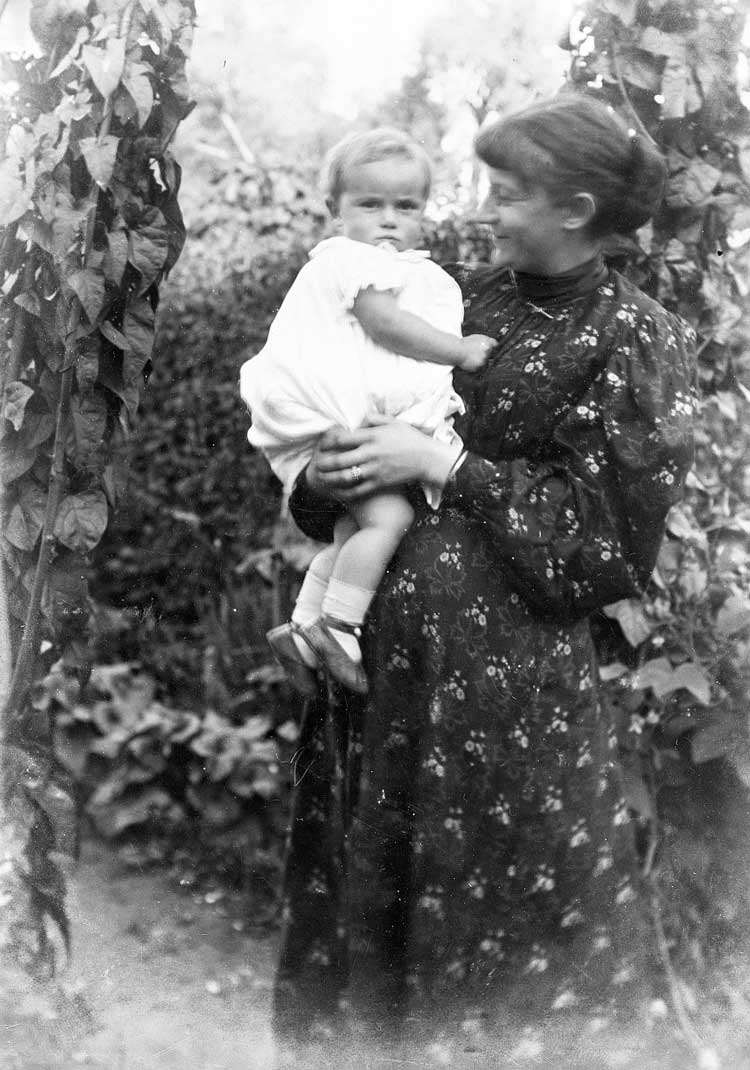
Mabel with Ben, c1896. From an album belonging to James Pryde. With kind permission of Bushey Museum and Art Gallery.
Mabel Pryde was born in Edinburgh in 1871, the youngest of six children. At 17, she was sent to Bushey Art School in Hertfordshire, where she met William Nicholson, with whom, in 1893, she was to elope. Spread over two large upstairs rooms, the exhibition begins with a couple of portraits of Mabel by William from around this time. The sickly yellow wallpaper in Lady in Yellow (1893), which reflects in Mabel’s dress and skin, calls to mind some of Walter Sickert’s gloomy interiors, as well as Charlotte Perkins Gilman’s The Yellow Wallpaper, a short story of psychological abuse and gaslighting, published the previous year.
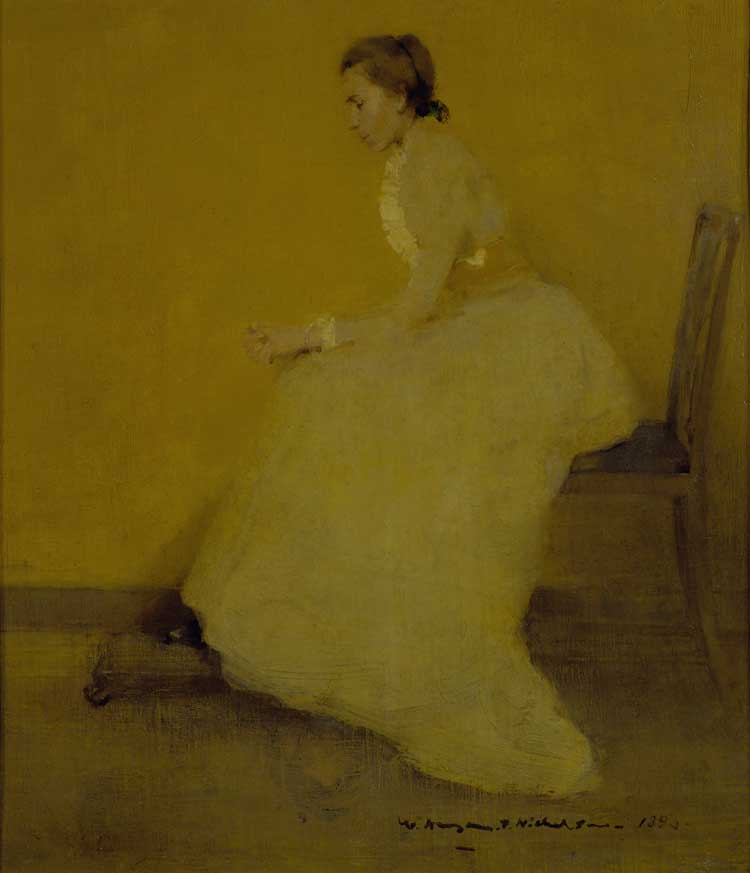
William Nicholson, Lady in Yellow, 1893. Private Collection.
Curiously, and perhaps a little unsettlingly, Nicholson has scratched out her face in a number of the photographs in the family albums. One such page is jokingly annotated by William – “torn out by Prydie – of course” – treating it as if it were a frequent family joke. While some have been wont to read into these actions, Davies believes Nicholson merely disliked how she looked. She was certainly shy and uneasy when it came to being portrayed, either on film or in paint. Mentions over the years – for example, in biographies of Ben – have not always been kind, even blaming her for her eldest son’s “insecure personality”, but, a loyal son, he always insisted she was his “rock”, blessed with “purpose and integrity”.2 Her character indeed seems to have been multifaceted, and her son-in-law Graves described her in his autobiography as “a beautiful, wayward Scotch-melancholy person”.3
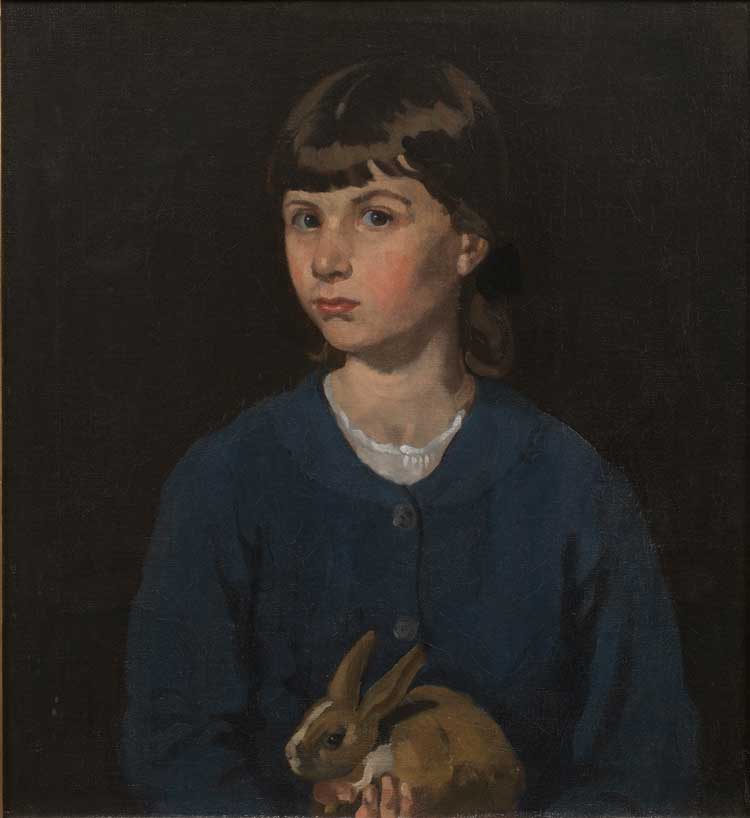
Mabel Pryde Nicholson, Nancy with Rabbit, c1909. Private Collection, courtesy of Patrick Bourne & Co., London.
There are a number of portraits of the children dressed in harlequin costumes, but we also see them captured as they read and play. A sequential hang, including Nancy with a Rabbit (c1910) and Kit as a Pirate (exhibited 1910), could almost have been composed using identikit eyes and nose, so similar are they, but if you compare these likenesses with the photographs nearby, you will see how accurate a representation this is of the children, who indeed are near carbon copies, not only of each other, but of their father William as well. A particular favourite of mine is Study of a Child (Kit Reading) (c1910), where the boy leans sleepily on his right elbow, his left hand leafing the page of his book. Another, in a wholly different and more formal style, is of Ben (c1910-14), where his petulant, teenage face is all that can be seen emerging from the black canvas (the use of such a dark background was emulating Manet, who, in turn, was mimicking Velázquez). Sneu-Ki or The Pekinese (c1912) depicts the family dog. His front paws on a red cushion, and his gaze looking directly out at the viewer, this portrait is simple and clear, narrowly escaping (but escaping all the same) kitschdom.
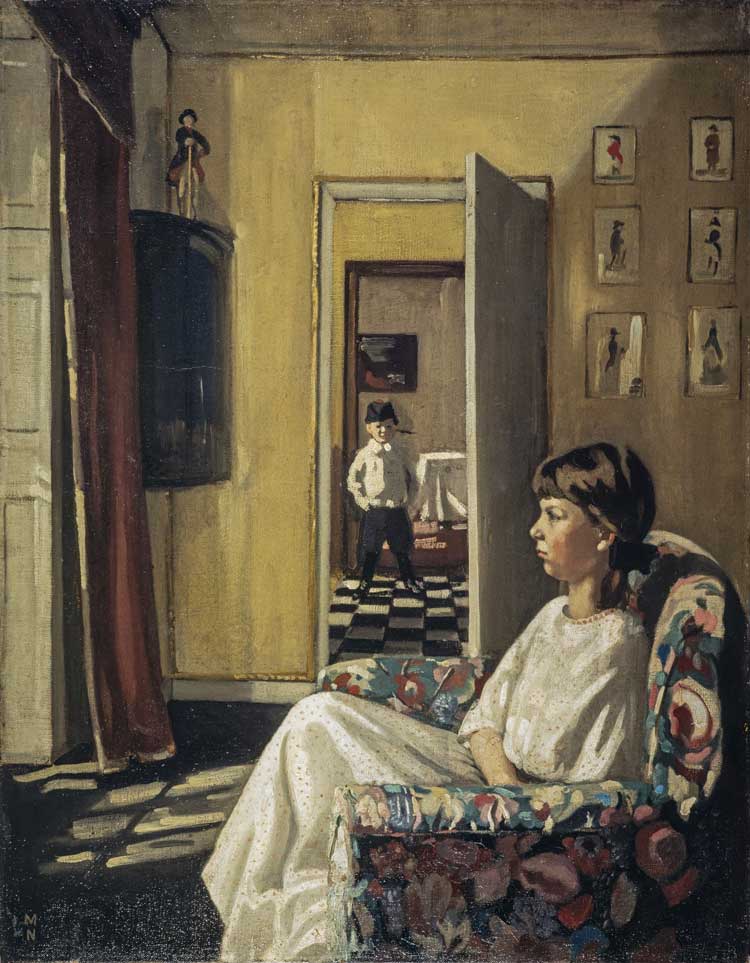
Mabel Pryde Nicholson, The Grange, c1911. Scottish National Gallery.
On the opposite wall there is a brilliantly perspectival double portrait of Nancy and Kit, titled The Grange (1911). It was painted in the room downstairs (of this, the team is certain, although, curiously, the door appears to have been moved in the intervening years), and I am told you can tell the time of day when the painting was made from the light falling on the floor. Also recognisable is the model ship, HMS Pandora (a model of the Royal Navy frigate, which, in 1790, had tracked down the Bounty mutineers at Tahiti), seen through the door in the next room with Kit, which may have been bought by William, when he was experimenting with shipping scenes, or may have been a gift from JM Barrie (the author of Peter Pan), who was a family friend, and for whom Ben, still a schoolboy at the time, had done some set designs.
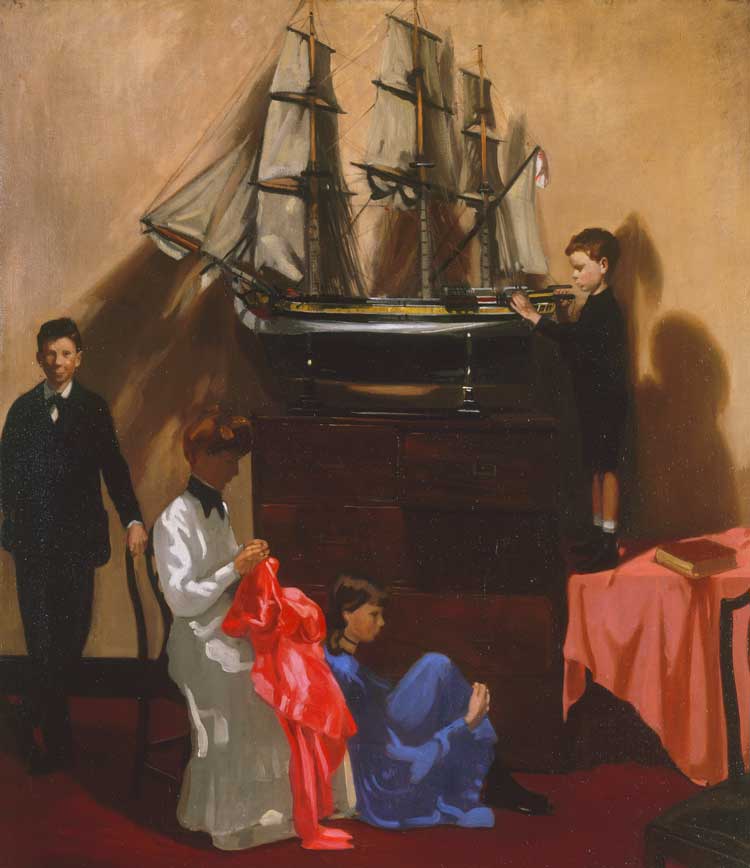
Mabel Pryde Nicholson, Family Group, c1912. Tate.
The ship recurs in Family Group (c1911), which sadly only appears in replica here. Tate agreed to loan the original, but, for various logistical reasons, not least the fact that it wouldn’t fit up the staircase, this couldn’t be realised. As copies go, however, this is a good one, and it is interesting to consider the figure in white, said to be the maid, but who arguably looks very much like a self-portrait of Nicholson. There is also a small reproduction of a family portrait by Willian Orpen (A Bloomsbury Family, 1907), which shows the same prints on the wall as in The Grange.
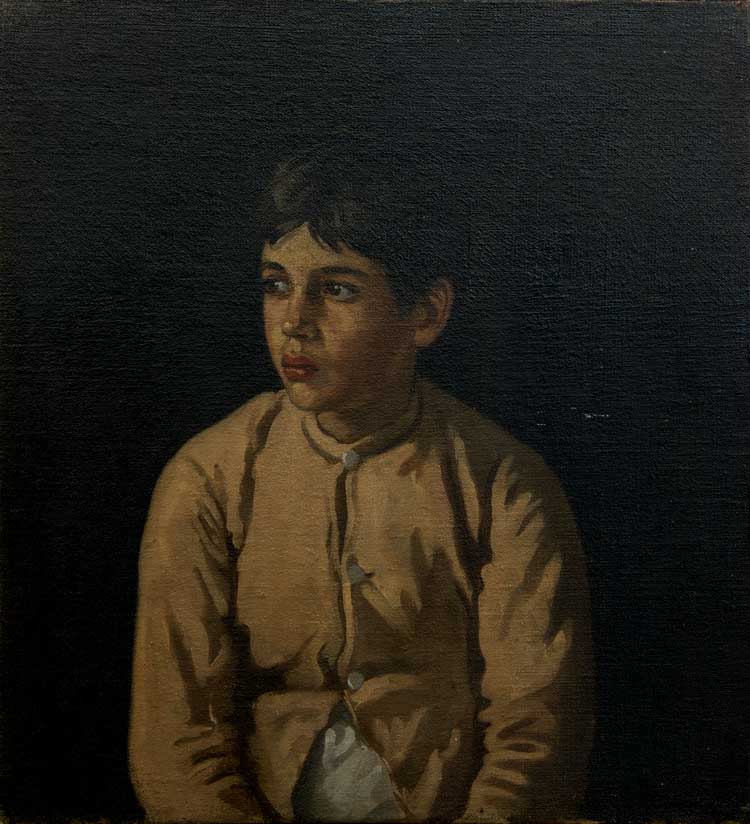
Mabel Pryde Nicholson, Ernesto, 1913. Pallant House Gallery.
Making up for any lack of authenticity with these portraits, Nicholson’s palette, hand mirror and perfume bottle displayed across the room, bringing her spirit alive. The balance of works to photographs is perhaps skewed in favour of the latter, but given that her children were Nicholson’s primary subjects, that this was their family home, and that motherhood was her primary vocation (for a while she stopped painting to focus on the welfare of her children), what elsewhere might seem like unnecessary padding, here seems reasonably appropriate. Moreover, there are not many more of Nicholson’s paintings that could have been included. She is thought to have made only between 40 and 50, of which only 20 are currently accounted for. Six of the remaining 20 to 30 works are shown small, in black-and-white, on a wall panel. It is easy to imagine how they would look in their full splendour among the rest. Serendipitously, the final painting in this room was a last-minute addition, after a reader of the Times responded to an article Davies wrote about the forthcoming exhibition, to say he thought he might have a painting of interest. It is the aforementioned beauty, depicting Kit decked out as a pirate. Finally, alongside the list of missing works, we can read the (brief) catalogue made to accompany an exhibition of 28 of Nicholson’s pictures, organised by Ben and Nancy a couple of years after her death, at the Goupil Gallery in London. A critic for the Sunday Times wrote at the time: “Mrs Nicholson holds as distinct and honourable a rank [among her cohort] as did Berthe Morisot among the French impressionists.”4 Yet her works have not been shown since – until now, that is. A positive long-term outcome of this exhibition, beyond reviving Nicholson’s name, is that the gallery is updating some of its permanent labels to honour her as well as William.
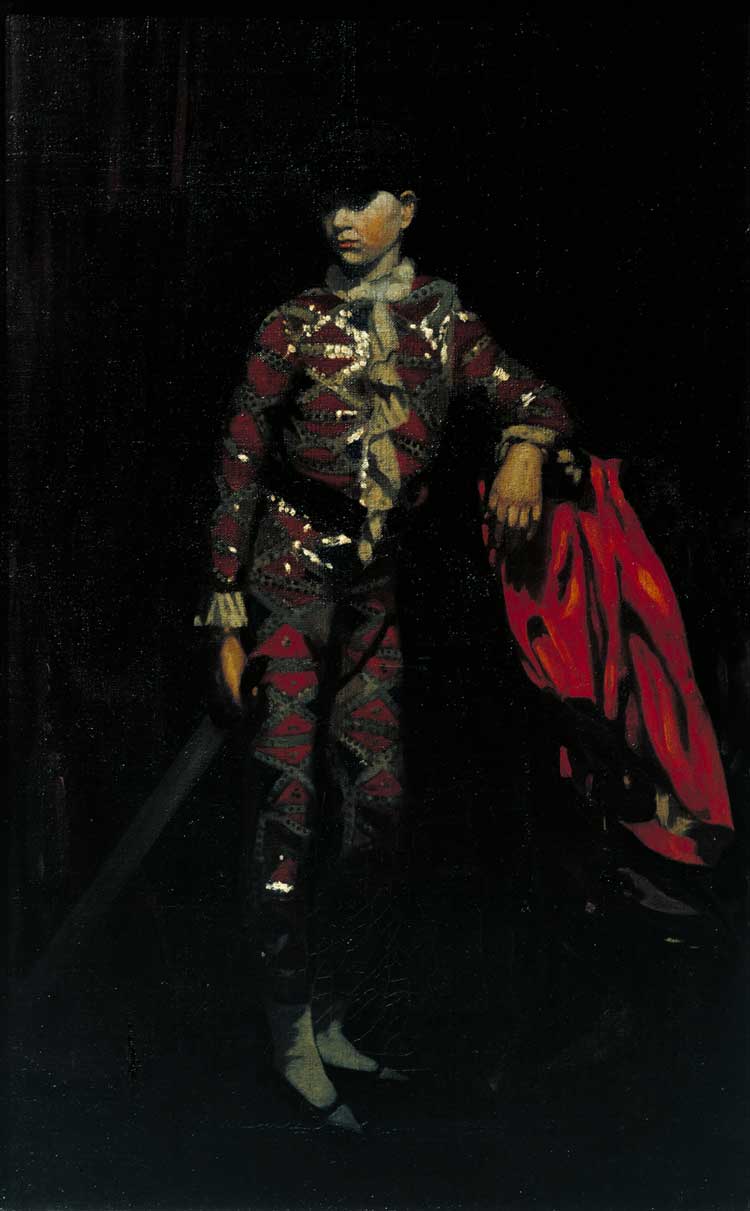
Mabel Pryde Nicholson, The Harlequin, c1910. Tate.
The second room begins with a timeline and family tree (very helpful for those of us confused by the many marriages and interrelations with other famous artist families) and then focuses on the Nicholson children and William, with a section on each, featuring their works (many sadly only in facsimile) and telling their stories. For example, there are some classic (facsimile) advertising posters by William, working together with Mabel’s brother Jimmy under the pseudonym Beggarstaffs; (facsimile) paintings by William of the local windmill under repair (1923) and the beach by moonlight (1910); a self-portrait of a 20-year-old Kit, who went on to die in a gliding accident in 1948, and an especially lovely portrait of him by Ben’s first wife, Winifred (c1928); a fantastical still life (with Lilliputian explorers clambering up ladders to reach the blooms of a large floral bouquet) (c1924) and a cover design for Vogue magazine (c1920s) by Nancy; and a somewhat curious portrait by Jimmy of Tony (c1903), who fought at the front in the first world war as 2nd Lieutenant in the Royal Field Artillery and died of gunshot wounds in 1918. He had been home on extended leave just weeks beforehand, unknowingly infecting his doting mother with the Spanish flu. Tragically, she did not survive and died aged 47 – a waste of much potential talent.
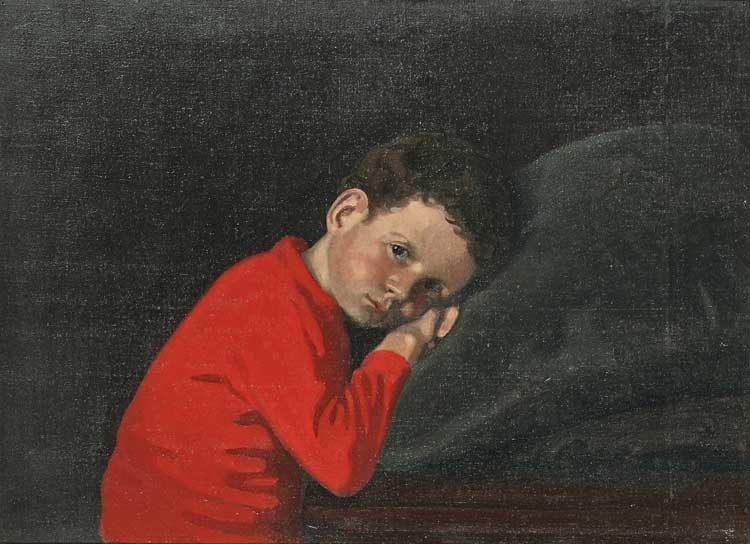
Mabel Pryde Nicholson, The Red Jersey, c1912. Aberdeen Art Gallery.
This exhibition is certainly worth a visit. So much so, that I made the five-hour return trip a second time in less than a fortnight, to revisit it with a friend, herself a portrait painter. In part, I thought she would enjoy it (she did); in part, I wanted to hear her opinion on the painterly skill – or otherwise – demonstrated by Nicholson. Searching for an adjective, my friend came up with “deft” to describe Prydie’s talents: “There is a confidence in the brushwork and some great handling of the paint. That ‘deftness’ made me expect that had she fully dedicated herself to painting, she would have been a pretty proficient artist.”5 Sadly, we will never know what Nicholson might have produced, had she survived.
References
1. Mabel Nicholson by Lucy Davies, Eiderdown Books, 2024.
2. Memoirs: WN by Ben Nicholson in London Magazine, June 1967, cited in op cit, page 2. 2.
3. Goodbye To All That by Robert Graves, Jonathan Cape, 1929, cited in op cit, page 41.
4. The Sunday Times, 18 April 1920, cited in op cit, page 48.
5. Thank you to Hero Johnson for her thoughts and company.